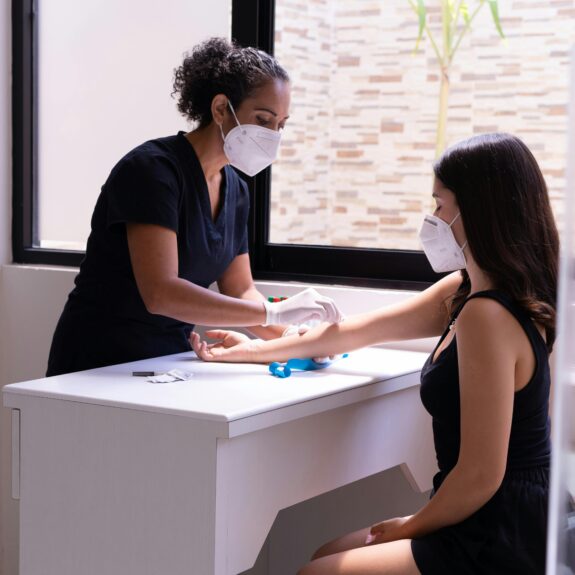Biological samples were donated near the time of participant enrollment or during subsequent collection campaigns. When participants donated a sample to CanPath, they also completed a sample donation questionnaire that captured key information such as physical state, time since last meal, and other factors that can influence biomarkers in blood or urine.
If a participant was unable to provide a blood sample due to medical or geographic reasons, a saliva sample was collected whenever possible. Dried blood spots were collected later as part of the COVID-19 serology project.
Storage and availability
- Blood and urine samples are stored at –80°C or –190°C (liquid nitrogen) in regional biorepositories across Canada.
- DNA is stored at –20°C or colder.
- Saliva samples were collected and stored according to regional protocols. Most regions used Oragene™ kits, stored at ambient temperature following the manufacturer’s guidelines prior to processing. The Atlantic PATH cohort, however, collected saliva in a cup without preservative; these are considered regional samples.
- CanPath also holds unique biosamples, including toenail clippings and cryo-preserved whole blood and PBMCs.
Each biosample type is maintained according to standardized operating procedures to ensure consistency and integrity across all regional cohorts. Not all sample types are available for all participants, and availability may vary by region and collection phase.
Guidance for researchers
This page serves as a reference guide for successful use of CanPath biosamples, highlighting possible analytical methods, biomarkers, and suggested sample quantities. For detailed costing, please visit the CanPath Cost-Recovery Access Fees page or contact the CanPath Access Office at apply@canpath.ca.
Available biosamples types
CanPath’s biosamples support a wide range of research applications across cancer, chronic disease, environmental exposure, and genomic studies. The sections below highlight the common biosample types available for access, along with typical analytical methods, biomarker categories, and required sample volumes.
For researchers seeking a more detailed technical overview, including expanded assay options and marker counts, download the CanPath Biosamples Reference Guide (PDF) — a comprehensive summary designed to support project planning and proposal development.
Download the CanPath Biosamples Reference Guide517 KBDownload🩸 Plasma & Serum
Overview:
Collected from participants during enrollment or follow-up, these samples are ideal for studying inflammation, metabolism, and disease-specific markers.
Possible Analyses:
- Luminex® (40–500 markers/test): Cytokines, chemokines, growth factors, MMPs, and disease-specific panels.
- Blood chemistry panels (7 markers/test): CRP, creatinine, ALT, albumin, and lipids (total cholesterol, HDL, LDL).
- NMR (~220+ markers/test): Metabolomics.
- OLink (48–5400 markers/test): Cardiovascular, oncology, inflammation, neurology, and biological process panels.
- ELISA (1 marker/test): Cytokines, lipid markers, melatonin, and other serology assays.
- LC-MS/HPLC/UHPLC: Pesticide exposure, proteomics, metabolomics, lipidomics.
Typical volume required: 20–500 µL
💧 Urine
Overview:
Urine samples provide valuable insights into environmental exposures, metabolic processes, and early indicators of disease.
Possible Analyses:
- LC–MS/UPLC: Metabolomics.
- UPLC-MS/MS: Toxicology.
- ELISA: Melatonin, SPARC, Survivin, SLIT-2, Uromodulin.
- Clinical urine chemistry panel (4 markers/test): Creatinine, sodium, potassium, microalbumin.
Typical volume required: 200 µL – 1 mL
🧬 DNA
Overview:
CanPath DNA samples support a wide range of genomic and epigenetic studies.
Possible Analyses:
- qPCR: gDNA levels, copy DNA, telomere length.
- Whole Genome Sequencing: ~3 billion markers/test.
- Axiom Genotype Platform (820K markers/test): Disease markers, genome-wide coverage for common variants.
- Affymetrix Human SNP 6.0 Array (906K markers/test): SNPs, CNV detection, and mitochondrial variants.
- Infinium HTS (654K markers/test): Genome-wide backbone, clinical markers, and QC markers.
- Infinium MethylationEPIC BeadChip (783K markers/test): DNA methylation studies.
Typical amount required: 5 ng – 1 µg
🧫 Red Blood Cells, Whole Blood & PBMCs
Overview:
Used for proteomics and hematologic studies. Cryo-preserved PBMCs and whole blood samples allow for cellular and flow cytometry analyses.
Possible Analyses:
- Immunoassay: HbA1c and proteomics.
- Mass spectrometry: Proteomics and protein modifications.
- Flow Cytometry: Immune profiling.
Typical volume required: ≤250 µL
🦶 Toenails
Overview:
Toenail samples can be analyzed for long-term environmental exposures such as heavy metal accumulation.
Possible Analyses:
- Metal testing (e.g., arsenic).
🩸 Dried Blood Spots
Overview:
Collected when standard venipuncture is not feasible; valuable for serological and antibody studies.
Possible Analyses:
- ELISA: COVID antibodies and other immune markers.
Quality and standards
CanPath’s biosample collection, processing, and storage follow a core set of standard operating procedures (SOPs) shared across all regional cohorts.
The Biosamples Standing Committee, led by Dr. Peter Watson (Director of Biobanking and Biospecimen Research Services, BC Cancer; Professor of Pathology, University of British Columbia; Adjunct Professor, University of Victoria), provides oversight and guidance to ensure national coordination, best practice sharing, and consistency across regions.
CanPath’s biosamples are housed and managed by regional biobanks within each cohort. Together, these form a federation of regional biobanks that collectively support CanPath’s research infrastructure.
Treena McDonald, CanPath’s National Biosample Coordinator, provides expert advice, assists in harmonizing biobanking protocols and procedures across regions, and helps facilitate national Approved Projects involving biosamples. She is also a member of the International Society for Biological and Environmental Repositories (ISBER).
Additional information
Abbreviations
- MS = Mass Spectrometry
- HPLC = High Performance Liquid Chromatography
- UHPLC = Ultra High Performance Liquid Chromatography
- LC = Liquid Chromatography
- MRM = Multiplex Reaction Monitoring
*Accuracy and reproducibility of some commercially available ELISA kits may vary (Chatziharalambous et al.). Investigate test findings before selecting assays.
Next steps
- Learn more about accessing biosamples through the CanPath Portal.
- For questions or costing details, contact the CanPath Access Office at apply@canpath.ca.
